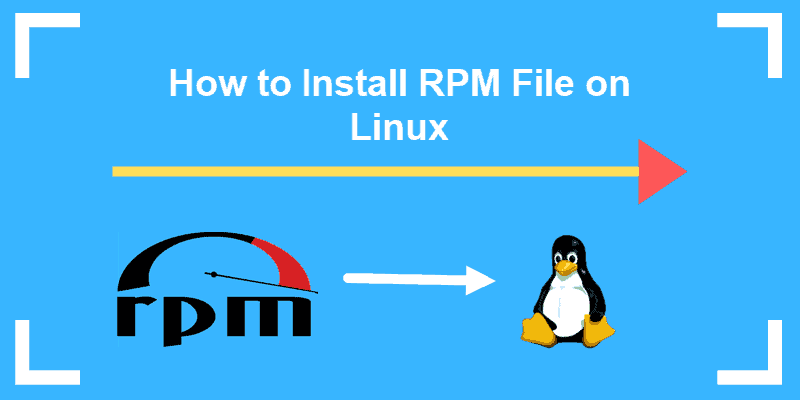How To Download A File On Centos UPDATED
How To Download A File On Centos
Introduction
While working in Linux, you lot may take seen downloadable files with the .rpm extension. Rpm files are designed to be downloaded and installed independently, outside of a software repository.
This guide will testify you lot how to install a .rpm file to your Linux CentOS or Fedora organization.

Note: RPM Packet Manager (RPM) is a free and open-source package direction system for installing, uninstalling and managing software packages in Linux.
Prerequisites
- A user account with sudo privileges
- Access to a terminal window / command line (Menu > applications > utilities > concluding, Ctrl-Alt-F2)
- RPM, DNF, & YUM Package Managers (all included by default)
Step 1: Download RPM Installation File
Typically, a web browser is used to locate and download a .rpm file. However, if a browser is non available you tin withal download a file if y'all know where information technology's located.
You may need to install a software tool called wget .
To install wget in CentOS, enter the following in a last window:
sudo yum install wget To install wget in Fedora, enter the following:
sudo dnf install wget At present, yous tin can use the wget command to download the .rpm file yous desire. Enter the post-obit:
wget http://some_website/sample_file.rpm The system should reach out to the website and download the file to your current working directory.
Notation: You can look up the address of a particular .rpm file in a web browser on another organisation. Besides, this is a handy way to install more than contempo software versions or special non-standard software. Also, take care when installing software packages! Make certain you trust the source before you install. Usually, a programmer will include a verification method to make sure you're getting authentic software.
Step 2: Install RPM File on Linux
Install RPM File Using RPM Command
To install a .rpm package in CentOS Linux, enter the post-obit:
sudo rpm -i sample_file.rpm The -i switch tells the package director you want to install the file.
More information on the RPM installer tin be found in the RPM documentation.
Install RPM File with Yum
Alternately, you tin use the yum package manager to install .rpm files.
Enter the following:
sudo yum localinstall sample_file.rpm The localinstall option instructions yum to look at your current working directory for the installation file.
Annotation: YUM stands for Yellowdog Updater Modified. Normally, yum looks to your enabled software repositories for new software packages to install. More contempo circumlocution suggests using install instead of localinstall, but it'due south upwardly to you.
Install RPM on Fedora
To install an .rpm package on Fedora Linux, enter the post-obit:
sudo rpm -i sample_file.rpm Only as in CentOS, the -i switch tells RPM to install the software.
Another method is to use the dnf utility to install the packet:
sudo dnf localinstall sample_file.rpm Different many Linux tools, DNF is not a set of initials. It is merely the next development of the yum package manager.
Remove RPM Package
The RPM installer tin be used to remove (or uninstall) a software bundle.
Enter the following into a concluding window:
sudo rpm -e sample_file.rpm The -e option instructs RPM to erase the software. Check RPM Dependencies
So far, this guide assumes the software either doesn't have dependencies or already has them installed.
To cheque the .rpm file for dependencies using the following control:
sudo rpm -qpR sample_file.rpm The system should list all the dependencies:
-
-q– This choice tells RPM to query the file -
-p– This option lets you specify the target package to query -
-R– This lists the requirements for the package
If there are any missing dependencies, you can install them from the standard repositories using yum or dnf. If your software requires other non-standard software, it will oft be noted in the installation instructions.
Download RPM Packages from the Repository
One heady feature of the yum package manager is that it allows y'all to download .rpm files directly from the repository. This might be helpful if yous accept limited bandwidth, or want to copy a unmarried downloaded file between systems. Information technology could besides assist if you lot have intermittent net admission, and you lot don't want to spend fourth dimension waiting for your installer to finish.
To download a .rpm file from the repositories, enter the post-obit:
sudo yumdownloader packagename If you wanted to download the files for Apache, for case, you'd replace packagename with httpd. Yous can then install the file every bit in a higher place.
Note: In Linux, administrators find it helpful to have a single tool to manage software. That tool – chosen apackage manager – can install software, keep track of software requirements, and track updates and patches. Package managers besides work withrepositories, which are secure and standardized libraries of commonly-used and well-supported applications. If you lot had to installwget in Step 1, that'due south an example of installing from a repository.
Conclusion
In this tutorial, we covered three different options for installing RPM files on Linux.
As with about Linux software, your default bundle director makes it unproblematic to track installations, updates, and prerequisites.
Was this commodity helpful?
Yes No
DOWNLOAD HERE
Posted by: claymily1964.blogspot.com
Post a Comment for "How To Download A File On Centos UPDATED"